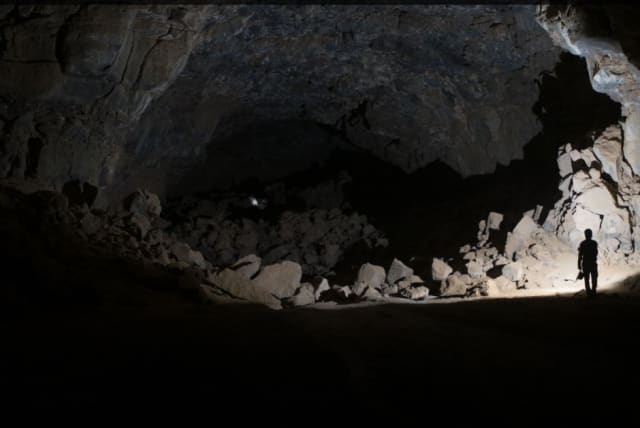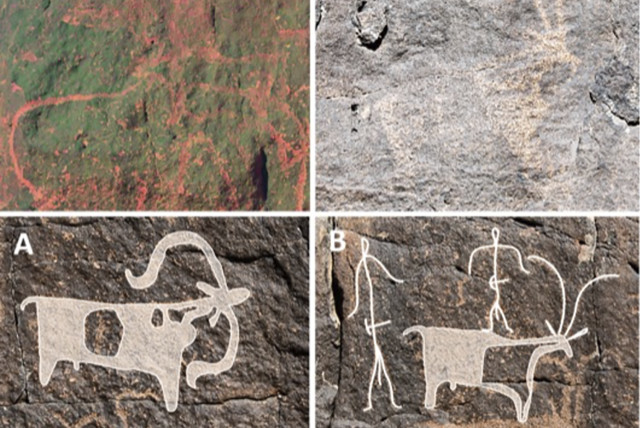Humans occupied lava tube in northern Saudi Arabia as shelter for thousands of years

A large tube produced by lava in the Umm Jirsan cave in Saudi Arabia sheltered humans for thousands of years.
A large tube produced by lava – molten rock (magma) that had been expelled from the interior of the earth – in the Umm Jirsan cave in northern Saudi Arabia provided valuable shelter for humans herding livestock over at least 7,000 years from the Neolithic through to the Chalcolithic/Bronze Age 10,000 to 3,500 years ago.Research over the last decade has highlighted a diverse Holocene archaeological record, but the timing of human occupations and their connections with the nearby Levant remain poorly understood, primarily due to poor preservation of organic remains in the region’s arid conditions.
To get around this problem, archaeologist Dr. Mathew an archaeologist at Australia’s Griffith University and Germany’s Max Planck Institutes of Geoanthropology and colleagues focused investigations on caves and other underground settings where ancient materials are sheltered from sun, wind and high fluctuations in temperature. They analyzed an archaeological site from a lava tube located in the volcanic field of Harrat Khaybar in Saudi Arabia about 125 kilometers north of Medina.
First evidence for human occupation of a lava tube in Arabia
The team that included scientists from the US, Europe and Australia has just been published in the journal PLoS ONE under the title “First evidence for human occupation of a lava tube in Arabia: The archaeology of Umm Jirsan Cave and its surroundings.” Within the lava tube, they found artifacts, rock art, and skeletal remains that documented repeated human occupation over at least seven millennia. The lava tube seems to have been an important resource for pastoralists keeping and herding livestock, as evidenced by rock art and animal bones representing domesticated sheep and goats. Isotopic analysis of human remains reveals an increase over time in plants such as cereal and fruit in the diet, possibly linked to a rise in oasis agriculture in the Bronze Age.
The authors believe that Umm Jirsan was likely not a permanent home, but instead a valuable stopping point for people traveling among oasis settlements. Lava tubes and other natural shelters were valuable resources for communities surviving in a challenging environment, and with further investigation, they present a key source of archaeological information about the history of human occupation in Arabia.
Humans lived sporadically in the area, when there was an improved, drier climate. “Our findings provide a rare glimpse into the lives of ancient peoples in Arabia, revealing repeated phases of human occupation and shedding light on the pastoralist activities that once thrived in this landscape,” said Stewart. “This site likely served as a crucial waypoint along pastoral routes, linking key oases, and facilitating trade and cultural exchanges.”
Herb-eating mammals grazed mostly on wild grasses and shrubs rather than being provided with fodder, while humans had a diet consistently high in protein but with increasing consumption of plants, perhaps related to the emergence of oasis agriculture.
“The proliferation of archaeological sites in the Holocene era has been interpreted as reflecting population growth in the region, spurred by the onset of the Holocene Humid Period at around 10,600 years before the present. This was followed by the introduction of domestic livestock, and later by the development of water-harnessing technologies (such as wells and dams) and oasis agriculture in the Bronze Age, when arid conditions returned. Many of the features that define the Neolithic elsewhere, such as sedentism, pottery, and agriculture, are notably absent from northern Arabia until the Bronze Age,” they concluded.
Jerusalem Post Store
`; document.getElementById("linkPremium").innerHTML = cont; var divWithLink = document.getElementById("premium-link"); if (divWithLink !== null && divWithLink !== 'undefined') { divWithLink.style.border = "solid 1px #cb0f3e"; divWithLink.style.textAlign = "center"; divWithLink.style.marginBottom = "15px"; divWithLink.style.marginTop = "15px"; divWithLink.style.width = "100%"; divWithLink.style.backgroundColor = "#122952"; divWithLink.style.color = "#ffffff"; divWithLink.style.lineHeight = "1.5"; } } (function (v, i) { });

